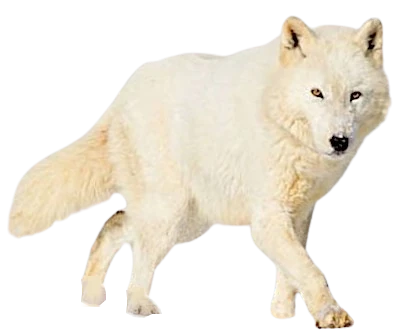
The Arctic Wolf (Canis lupus arctos) is a carnivorous canid known for its cold resistance and ability to survive in extreme environments. This wolf is primarily found in the Arctic regions of North America and Greenland.
The Arctic Wolf is distinguished by its thick white fur, which helps it blend into the snow and protects it from extreme temperatures. It measures about 1 to 1.5 meters in length, including its tail, and weighs between 45 and 80 kg. Its ears are smaller and rounder than those of other wolves, helping to minimize heat loss.
The Arctic Wolf belongs to the Canid family.
This wolf is one of the most specialized subspecies of the Gray Wolf, adapted to life in Arctic environments.
The Arctic Wolf primarily lives in the Arctic regions of North America and Greenland. It prefers tundra and taiga areas, where it can find prey and protect itself from extreme temperatures.
This canid is very social and lives in family packs. Packs are typically composed of a breeding pair and their offspring. Arctic wolves are highly territorial and mark their territory with scents and howls. They are primarily active at night and during twilight.
Carnivorous, the Arctic Wolf primarily feeds on caribou, muskoxen, and small mammals like Arctic hares. During lean times, they may also consume fish and carrion. Their diet is adapted to the available resources in their Arctic environment.
Although the Arctic Wolf is not in immediate danger of extinction, it faces threats such as climate change, habitat loss, and conflicts with humans. Protecting their natural habitat and managing prey populations are essential for their survival.
The Arctic Wolf belongs to the species Canis lupus, which also includes the Gray Wolf (Canis lupus). These two subspecies share common characteristics, but the Arctic Wolf is uniquely adapted to life in Arctic environments. Its adaptations include a thick white fur that provides camouflage in the snow, wide paws for walking on ice, and a diet often based on rare prey such as musk oxen.
To observe the Arctic Wolf in its natural habitat, follow these tips:
By following these recommendations, you can admire this fascinating animal while minimizing disturbances.